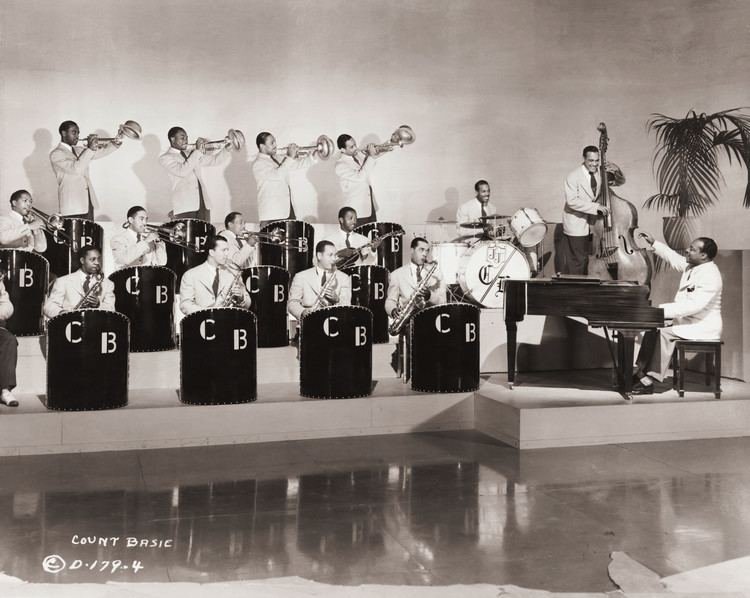William James “Count” Basie (1904–1984) was one of the most influential bandleaders and pianists of the Swing Era. Renowned for his distinct style of piano “comping,” tightly swinging rhythm section, and relaxed yet powerful arrangements, Basie played a central role in shaping the distinctive Kansas City style of jazz.
Born in Red Bank, New Jersey, in 1904, Basie learned piano from his mother and began performing in vaudeville shows as a teenager. Between 1923 and 1926, he spent significant time in Harlem, where he developed his technique under the informal guidance of stride piano legend Fats Waller. In 1927, while touring with a show, Basie was stranded in Kansas City. He remained in the city, where he played in movie theater pit bands and joined Walter Page’s Blue Devils, before becoming the pianist for Bennie Moten’s Kansas City Orchestra.
Moten’s band had already developed a distinctive regional sound that emphasized twelve-bar blues forms, riff-based arrangements, and a powerful rhythm section. After Moten’s unexpected death in 1935, Basie formed his own band, employing many members from the Moten ensemble.In contrast to Duke Ellington, who composed with the unique tone of each musician in mind, Basie focused on creating a cohesive sound within each section and recruited players to fit that vision. While his band emphasized unified grooves, tight riffs, and a rhythmic drive rather than complex arrangements, Basie still made space for individual solos that showcased musicians’ talents.
A pivotal moment in Basie’s career came in 1936, when influential producer and critic John Hammond discovered a faint radio broadcast of Basie’s performance at Club Reno in Kansas City on station WXBY. Impressed by the sound, Hammond invited Benny Goodman to hear Basie live and quickly arranged bookings in Chicago and New York, as well as national tours and recording contracts. By 1937, the Count Basie Orchestra had signed with Decca Records and relocated to New York, where they became one of the most popular swing bands in the country. A 1938–1939 residency at the Famous Door, a small jazz club in Manhattan, featured almost nightly national network radio broadcasts, further elevating Basie’s national profile.
At the core of Basie’s band was its groundbreaking rhythm section, which set the standard for future jazz ensembles:
Basie on piano, renowned for his syncopated comping—interjecting rhythmic and harmonic chords between horn lines with precision and subtlety.
Walter Page on bass, a pioneer of the walking bass line, playing a steady note on each beat in smooth ascending or descending patterns that anchored the band’s swinging groove.
Freddie Green on guitar, providing a gentle but steady rhythmic pulse through his consistent four-beat chord strumming, adding a subtle drive that kept the ensemble moving.
Jo Jones on drums, who transformed the rhythmic feel by emphasizing the hi-hat cymbal rather than the bass drum, creating a lighter, more buoyant swing that energized the band’s sound.
Basie’s piano style was also influenced by boogie-woogie, particularly in his use of left-hand ostinatos—repeated rhythmic figures that grounded his otherwise minimalist right-hand comping. The overall result was a sound that was light, flexible, and perfect for dancing, yet filled with subtle musical interplay.
One of the band’s most celebrated members was tenor saxophonist Lester Young, whose cool, laid-back phrasing and light tone offered a striking contrast to the heavier style of contemporaries like Coleman Hawkins. Young’s improvisational approach would later shape the language of bebop and influence saxophonists like Charlie Parker.
Count Basie’s style and approach are captured in classic recordings such as "Lester Leaps In" and "Straight Ahead," both of which highlight the band’s tight ensemble work, compelling rhythm section, and dedication to swinging feel. The Basie sound became a staple in dance halls, theaters, colleges, and hotels, and his band remained in high demand throughout the Swing Era and beyond.
In the 1950s, Basie embarked on international tours that established him as a global ambassador of jazz, and he continued to perform and record into the 1980s. He died of pancreatic cancer in 1984, but the Count Basie Orchestra continued under new leadership, a testament to the lasting power of his music and his vision.



